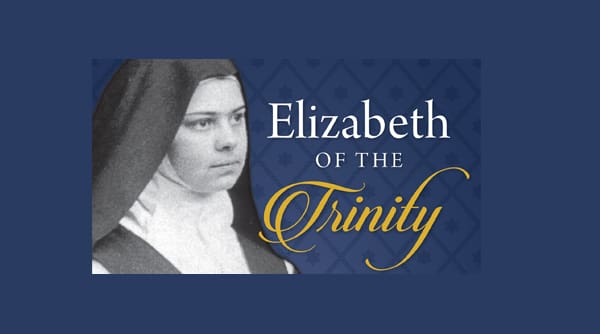Elizabeth of the Trinity’s Lived Spirituality
Elizabeth of the Trinity crossed the threshold of the Dijon Carmel aware that she was embracing a life that, by vocation and mission, had prayer, silence, solitude, and an unceasing conversation with God at its center. She felt called to consecrate her entire existence to a living relationship with God-Trinity, with Christ, as an expression of a love that desires to be, in the words of St. Thérèse, “a lifting of the heart, a simple glance to heaven, a cry of gratitude and love amidst trials and joy.”*
Her sense of the call to consecrate her entire existence highlights the fact that, for Elizabeth, life and doctrine, experience and writings, combine and complete each other, each one enlightening the other. With the clarity of that enlightenment, the great themes of her lived spirituality can be understood: the presence of the Trinity within her being, conformity to Christ, the making of her existence into a praise of the glory of God: all of these unified and ordered toward a deeply lived life of faith.
Elizabeth’s spiritual journey highlighted the mystery of the Trinity, present by grace in the soul of every baptized person. Her name tells her she is the “house of God” in which live the Three Divine Persons: the Father, the Son, and the Holy Spirit.
For Elizabeth, the adoration of the Trinity in the soul makes earthly life something sublime, capable of conferring unhoped-for experiences of that intimate love that forgets itself and exists solely for the other. “Dear little sister,” she exclaims in a letter, “let us lose ourselves in this Holy Trinity, in the God-All-Love; let us allow ourselves to be carried away to that place where there is nothing but Him, Him alone!”
She lived with such a certainty of faith, matured at the school of John of the Cross, that only Christ could sustain her in her intentions, her intimate desires. “I feel my impotence,” she confesses. From this realization blooms her great yearning to disappear in Christ, to be clothed with Him; to give over her very life, abandoning it in Him, to become a radiating of His life. “It seems to me that the saints are souls who at every moment forget themselves; they lose themselves so completely in Him whom they love, that without returning to themselves, without creaturely regret, they can say with St. Paul, ‘it is no longer I who live, but Christ who lives in me’ [Gal. 2:20]. In order to arrive at this transformation, one must without a doubt offer himself as a victim.”
The “vivit in me Christus” (Gal. 2:20) that she experienced while listening to the Word and the powerful transformative action of the Holy Spirit that held her in His grip coincide in Elizabeth with the affirmation of her longing to be for Christ “an extra-added humanity, in which He can renew all His mystery” as Adorer of the Father, as Reparator of the sins of a world distant from the faith, and as Savior cruelly killed on Calvary.
These are not pet images or dreams that clothe the existence of a Carmelite monastic, nor are they simply echoes of her un-containable love for Christ-All-Love, who destroyed her fragile health in the divine flames. They are real experiences, come about in the depths of the soul, where a voice whispers: “Die every day” (1 Cor. 15:31).
I diminish; I renounce myself more each day so that Christ grows and is exalted in me. . . . I place the joy of my soul (as far as I will it, not as far as I feel) in all that which can sacrifice me, destroy me, lower me, because I want to make way for my Maestro. . . . I don’t want to live my own life, but to be transformed into Jesus Christ so that my life is more divine than human and the Father, bending low over me, may recognize in me the image of His Beloved Son.
Elizabeth outlined these thoughts at the end of her life, almost as if to gather the fruits of the steadfast commitment of her final years to order the events of her Carmelite existence according to the great Pauline themes.
As a matter of fact, it was beginning in 1903 that the apostle guided her with exhortations and Christological texts toward complete conformity with Christ on Calvary. There she finds the strength to bear atrocious pains without complaint. “I never met a soul that overcame pain with such serenity, without caving in on itself, in all and through all preoccupied with the presence of God and with her own vocation as ‘praise of glory,’” said Fr. Michael Philipon, the most famous expert on the life in the Dijon Carmel.
Beginning with Palm Sunday 1906, when an acute episode threatened her life, the nearness of death, so long desired, became a moment of ecstasy. She was disappointed not to have flown to heaven, and she didn’t hide that fact from her mother.
Writing to a friend, she spoke of the joy she felt “at the thought of her first face-to-face encounter with Divine Beauty. Oh, if only I had gone to lose myself in Him!”87 And in another place, she again remarked about the happiness of “the indescribable days spent waiting for the great vision [of light].”
She continued to hope she would go soon, but the sound methods of God would make her wait five more months, comparable to a slow death. It was five months of a final purification to dissolve all the doubts that remained in her, all the imperfections in her burning desire. And what she had to say about death became more painful, more filled with suffering, because death is not a joyful mystery. Elizabeth had to convince her very own flesh to “be conformed to Christ in His death” (cf. Phil. 3:10).
This change in Elizabeth struck the noted Swiss theologian Hans Urs von Balthasar, who arrived at this conclusion: “The tendency toward the afterlife and the accentuated desire to not establish herself permanently here below, to live on earth as if on tip-toes, preferring to stay suspended in the air above the ground, is a behavior which should not be ascribed to ‘grace,’ because it is founded in ‘nature’, and at first it is indifferent to grace and the demands of grace, if not diametrically opposed to it. Christianity is neither a flight from the world nor an annoyed submission to it.”
Consequently, at least so it seems to von Balthasar, “Elizabeth during her final sufferings finds the way of perfect indifference with much less ease than St. Thérèse [of Lisieux]. She wants to die with every fiber of her being; she fights to fade away and to be with Christ — away from everything, and headlong down into the boundless abyss of God. She sees her apostolate is to infect as many as possible with her ardent hope for the infinite. It is a behavior that we cannot completely fathom.”
This truly was the predicament of Elizabeth’s life, but von Balthasar fails to see how grace intervened and was victorious over the inclinations of her “nature” — a term that seems poorly chosen because in her everything is born and develops within the scope of prayer, and even more so because her nature is strongly gifted with sensibility, affection, and intuition.
In any case, Elizabeth needs to be overcome, like all Christians, by the overwhelming anguish of death, by the emptiness that rules a condition of destruction. In fact, toward the beginning of September 1906, two months before the arrival of the Beloved Bridegroom, she was able to recognize that finding herself in “extreme weakness” she had truly succeeded in “completing in [her] flesh that which lacks in the sufferings of Jesus Christ for His body which is the Church” (cf. Col. 1:24). No less was her silent joy at being chosen by God “to join with the sufferings of her Christ,” but at the same time she realized in her prostrated state and continual pains that she must believe with humility and preserve her hope until that day in which the Lord would say to her, “Come.”
*Thérèse of the Child Jesus, Autobiographical Writings C, 317, in Gli Scritti, p. 289.
+
 This article is from a chapter in Elizabeth of Trinity: A Life of Praise to God, which is available through Sophia Institute Press.
This article is from a chapter in Elizabeth of Trinity: A Life of Praise to God, which is available through Sophia Institute Press.
Art for this post on Elizabeth of the Trinity’s Lived Spirituality: Cover of Elizabeth of the Trinity used with permission.






